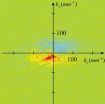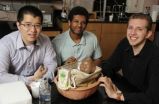(Press-News.org) Researchers with the U.S. Department of Energy (DOE)'s Lawrence Berkeley National Laboratory (Berkeley Lab) have once again demonstrated the incredible capabilities of metamaterials – artificial nanoconstructs whose optical properties arise from their physical structure rather than their chemical composition. Engineering a unique two-dimensional sheet of gold nanoantennas, the researchers were able to obtain the strongest signal yet of the photonic spin Hall effect, an optical phenomenon of quantum mechanics that could play a prominent role in the future of computing.
"With metamaterial, we were able to greatly enhance a naturally weak effect to the point where it was directly observable with simple detection techniques," said Xiang Zhang, a faculty scientist with Berkeley Lab's Materials Sciences Division who led this research. "We also demonstrated that metamaterials not only allow us to control the propagation of light but also allos control of circular polarization. This could have profound consequences for information encoding and processing."
Zhang is the corresponding author of a paper describing this work in the journal Science. The paper is titled "Photonic Spin Hall Effect at Metasurfaces." Co-authors are Xiaobo Yin, Ziliang Ye, Jun Sun Rho and Yuan Wang.
The spin Hall effect, named in honor of physicist Edwin Hall, describes the curved path that spinning electrons follow as they move through a semiconductor. The curved movement arises from the interaction between the physical motion of the electron and its spin – a quantized angular momentum that gives rise to magnetic moment. Think of a baseball pitcher putting spin on a ball to make it curve to the left or right.
"Light moving through a metal also displays the spin Hall effect but the photonic spin Hall effect is very weak because the spin angular momentum of photons and spin-orbit interactions are very small," says Xiaobo Yin, a member of Zhang's research group and the lead author of the Science paper. "In the past, people have managed to observe the photonic spin Hall effect by generating the process over and over again to obtain an accumulative signal, or by using highly sophisticated quantum measurements. Our metamaterial makes the photonic spin Hall effect observable even with a simple camera."
Metamaterials have garnered a lot of attention in recent years because their unique structure affords electromagnetic properties unattainable in nature. For example, a metamaterial can have a negative index of refraction, the ability to bend light backwards, unlike all materials found in nature, which bend light forward. Zhang, who holds the Ernest S. Kuh Endowed Chair Professor of Mechanical Engineering at the University of California (UC) Berkeley, where he also directs the National Science Foundation's Nano-scale Science and Engineering Center, has been at the forefront of metamaterials research. For this study, he and his group fashioned metamaterial surfaces about 30 nanometers thick (a human hair by comparison is between 50,000 and 100,000 nanometers thick). These metasurfaces were constructed from V-shaped gold nanoantennas whose geometry could be configured by adjusting the length and orientation of the arms of the Vs.
"We chose eight different antenna configurations with optimized geometry parameters to generate a linear phase gradient along the x direction," says Yin. "This enabled us to control the
the propagation of the light and introduce strong photon spin-orbit interactions through rapid changes in direction. The photonic spin Hall effect depends on the curvature of the light's trajectory, so the sharper the change in propagation direction, the stronger the effect."
Since the entire metasurface sample measured only 0.3 millimeters, a 50-millimeter lens was used to project the transmission of the light through the metamaterial onto a charge-coupled device (CCD) camera for imaging. From the CCD images, the researchers determined that both the control of light propagation and the giant photonic spin Hall effect were the direct results of the designed meta-material. This finding opens up a wealth of possibilities for new technologies.
"The controllable spin-orbit interaction and momentum transfer between spin and orbital angular momentum allows us to manipulate the information encoded on the polarization of light, much like the 0 and 1 of today's electronic devices," Yin says. "But photonic devices could encode more information and provide greater information security than conventional electronic devices."
Yin says the ability to control left and right circular polarization of light in metamaterial surfaces should allow for the formation of optical elements, like highly coveted "flat lenses," or the management of light polarization without using wave plates.
"Metamaterials provide us with tremendous design freedom that will allow us to modulate the strength of the photonic spin Hall effect at different spatial locations," Yin says. "We knew the photonic spin Hall effect existed in nature but it was so hard to detect. Now, with the right metamaterials we can not only enhance this effect we can harness it for our own purposes."
INFORMATION:
This research was supported by the DOE Office of Science.
Lawrence Berkeley National Laboratory addresses the world's most urgent scientific challenges by advancing sustainable energy, protecting human health, creating new materials, and revealing the origin and fate of the universe. Founded in 1931, Berkeley Lab's scientific expertise has been recognized with 13 Nobel prizes. The University of California manages Berkeley Lab for the U.S. Department of Energy's Office of Science. For more, visit http://www.lbl.gov.
DOE's Office of Science is the single largest supporter of basic research in the physical sciences in the United States, and is working to address some of the most pressing challenges of our time. For more information, please visit the Office of Science website at science.energy.gov/.
Berkeley Lab researchers use metamaterials to observe giant photonic spin hall effect
2013-03-22
ELSE PRESS RELEASES FROM THIS DATE:
Program improves Ph.D. student diversity
2013-03-22
PROVIDENCE, R.I. [Brown University] — A new paper in the peer-reviewed journal CBE—Life Sciences Education describes a Brown University program that has significantly improved recruiting and performance of underrepresented minority students in its nine life sciences doctoral programs over the last four years.
Data in the paper show increases in applications, admissions, enrollments, test scores, grades and scientific publications and presentations among underrepresented minority students after implementation of the program called the Initiative to Maximize Student Development ...
New method developed to expand blood stem cells for bone marrow transplant
2013-03-22
NEW YORK (March 21, 2013) -- More than 50,000 stem cell transplants are performed each year worldwide. A research team led by Weill Cornell Medical College investigators may have solved a major issue of expanding adult hematopoietic stem cells (HSCs) outside the human body for clinical use in bone marrow transplantation -- a critical step towards producing a large supply of blood stem cells needed to restore a healthy blood system.
In the journal Blood, Weill Cornell researchers and collaborators from Memorial-Sloan Kettering Cancer Center describe how they engineered ...
Pain reliever shows anti-viral activity against flu
2013-03-22
The over-the-counter anti-inflammatory drug naproxen may also exhibit antiviral activity against influenza A virus, according to a team of French scientists. The finding, the result of a structure-based investigation, is published online ahead of print in the journal Antimicrobial Agents and Chemotherapy.
New influenza vaccines must be developed annually, because the surface proteins they target mutate rapidly, the way cars used to get a whole new look every year. The researchers, led by Anny Slama-Schwok of the Institut National de la Recherche Agronomique, Jouy en ...
Scientists create new tools for battling secondhand smoke
2013-03-22
Dartmouth researchers have taken an important step in the ongoing battle against secondhand tobacco smoke. They have pioneered the development of a breakthrough device that can immediately detect the presence of secondhand smoke and even third-hand smoke.
Smaller and lighter than a cellphone and about the size of a Matchbox car, the device uses polymer films to collect and measure nicotine in the air. A sensor chip then records the data on an SD memory card. The technology is described in a new study appearing in the journal Nicotine and Tobacco Research.
"We have ...
Study offers new way to discover HIV vaccine targets
2013-03-22
Decades of research and three large-scale clinical trials have so far failed to yield an effective HIV vaccine, in large part because the virus evolves so rapidly that it can evade any vaccine-induced immune response.
Researchers from the Ragon Institute of MGH, MIT and Harvard University have now developed a new approach to vaccine design that may allow them to cut off those evolutionary escape routes. The researchers have developed and experimentally validated a computational method that can analyze viral protein sequences to determine how well different viral strains ...
Banning food ads targeted at kids
2013-03-22
Researchers from the University of Alberta are leading a charge among Canada's obesity experts and calling on the federal government to ban food and beverage ads that target children.
Kim Raine, a professor with the Centre for Health Promotion Studies in the School of Public Health at the U of A, says governments need to take action to stem the rising obesity epidemic. The only exception to a proposed food and beverage marketing ban would be for approved public health campaigns that promote healthy eating.
"Restricting marketing is not going to be a cure for childhood ...
Enzymes allow DNA to swap information with exotic molecules
2013-03-22
The discovery of the Rosetta Stone resolved a longstanding puzzle, permitting the translation of Egyptian hieroglyphs into Ancient Greek.
John Chaput, a researcher at Arizona State University's Biodesign Institute has been hunting for a biological Rosetta Stone—an enzyme allowing DNA's 4-letter language to be written into a simpler (and potentially more ancient) molecule that may have existed as a genetic pathway to DNA and RNA in the prebiotic world.
Research results, which recently appeared in the Journal of the American Chemical Society, demonstrate that DNA sequences ...
Breakthrough could lead to cheaper, more sustainable chemical production
2013-03-22
PROVIDENCE, R.I. [Brown University] — A key advance, newly reported by chemists from Brown and Yale Universities, could lead to a cheaper and more sustainable way to make acrylate, an important commodity chemical used to make materials from polyester fabrics to diapers.
Chemical companies churn out billions of tons of acrylate each year, usually by heating propylene, a compound derived from crude oil. "What we're interested in is enhancing both the economics and the sustainability of how acrylate is made," said Wesley Bernskoetter, assistant professor of chemistry at ...
Low-cost 'cooling cure' would avert brain damage in oxygen-starved babies
2013-03-22
When babies are deprived of oxygen before birth, brain damage and disorders such as cerebral palsy can occur. Extended cooling can prevent brain injuries, but this treatment is not always available in developing nations where advanced medical care is scarce. To address this need, Johns Hopkins undergraduates have devised a low-tech $40 unit to provide protective cooling in the absence of modern hospital equipment that can cost $12,000.
The device, called the Cooling Cure, aims to lower a newborn's temperature by about 6 degrees F for three days, a treatment that has been ...
UF fossil bird study on extinction patterns could help today's conservation efforts
2013-03-22
GAINESVILLE, Fla. — A new University of Florida study of nearly 5,000 Haiti bird fossils shows contrary to a commonly held theory, human arrival 6,000 years ago didn't cause the island's birds to die simultaneously.
Although many birds perished or became displaced during a mass extinction event following the first arrival of humans to the Caribbean islands, fossil evidence shows some species were more resilient than others. The research provides range and dispersal patterns from A.D. 600 to 1600 that may be used to create conservation plans for tropical mountainous regions, ...



